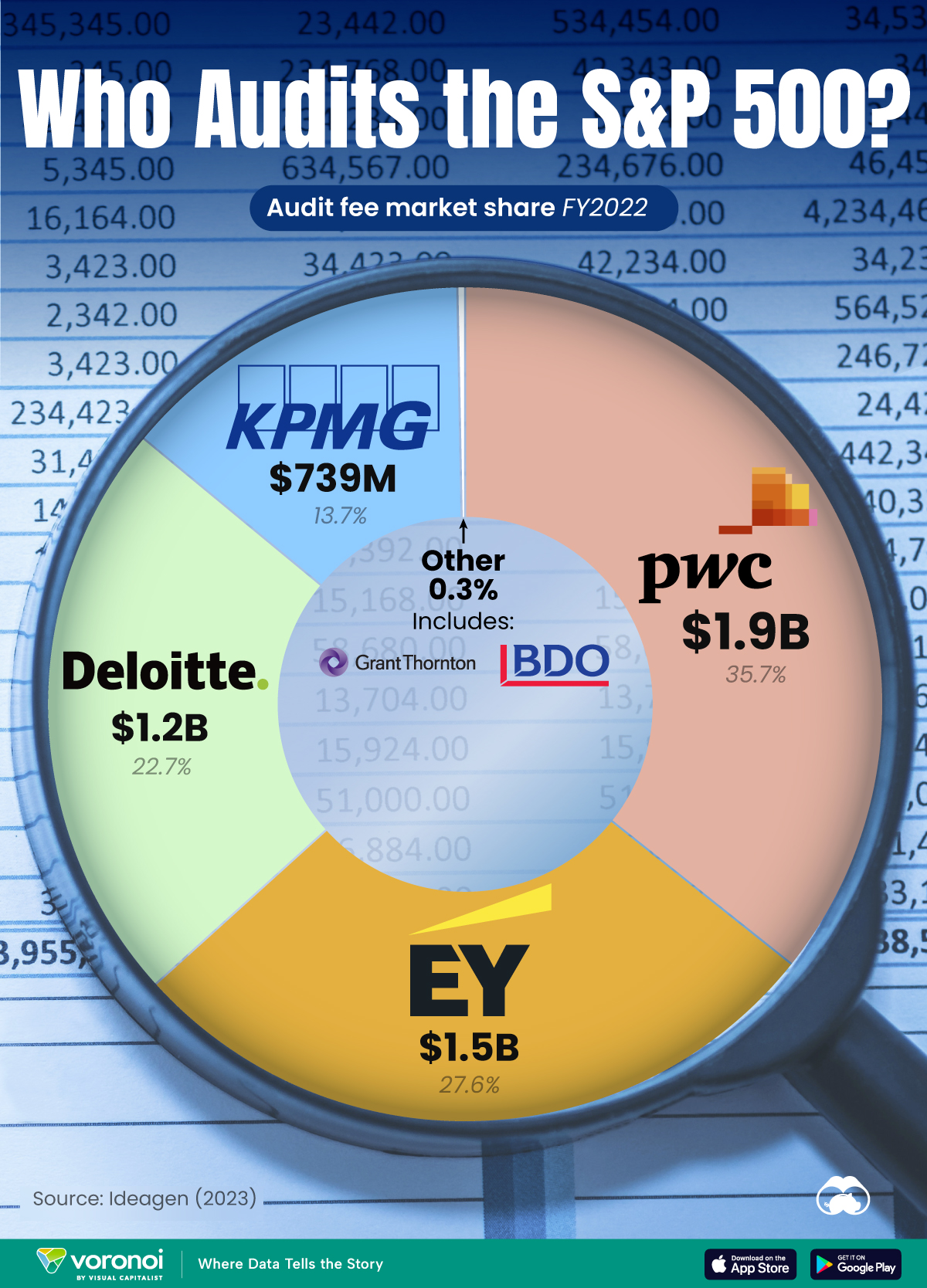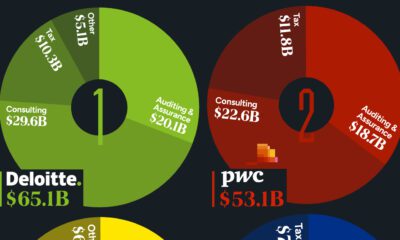Markets
Charted: Big Four Market Share by S&P 500 Audits
![]() See this visualization first on the Voronoi app.
See this visualization first on the Voronoi app.
Charted: Big Four Market Share by S&P 500 Audits
This was originally posted on our Voronoi app. Download the app for free on Apple or Android and discover incredible data-driven charts from a variety of trusted sources.
The companies on the S&P 500 together paid $5.3 billion in audit fees in fiscal year (FY) 2022. But which accounting firm took home the lion’s share of that windfall?
To find out, we visualized the Big Four’s market share of S&P 500 audits using data published by Ideagen in August 2023.
Who Audits the S&P 500?
PricewaterhouseCoopers claims the largest share of S&P 500 companies’ audit fees, at a massive $1.9 billion. Given the firm’s 152 clients among the index, this translates to roughly $12.6 million in revenue per relationship.
| Rank | Company | Audit Fees from S&P 500 | Market Share |
|---|---|---|---|
| 1 | PwC | $1.9B | 35.7% |
| 2 | EY | $1.5B | 27.6% |
| 3 | Deloitte | $1.2B | 22.7% |
| 4 | KPMG | $739M | 13.7% |
| N/A | Other | $15M | 0.3% |
Ernst & Young ($1.5 billion) and Deloitte ($1.2 billion) rank second and third, with KPMG a distant fourth at $739 million.
KPMG is generally considered the laggard of the Big Four accounting firms, and has faced more challenging times in the last few years. For instance, it was the auditor of the three U.S. banks that failed in 2023.
And in 2020, the firm had the worst report card of the Big Four, with only 61% of its sampled audits meeting industry standards.
Nevertheless the Big Four still maintain an ironclad grip on the general auditing business. Grant Thornton and BDO USA, the two other firms that audited the index, together only managed about $15 million in fees.
Which S&P 500 Companies Pay the Most Audit Fees?
Ideagen found that Manufacturing and Finance sectors paid the most audit fees, comprising nearly 69% of the $5.3 billion total paid by the index.
| Rank | S&P 500 Sector | Market Share | Audit Fees (FY22) |
|---|---|---|---|
| 1 | 🏭 Manufacturing | 43.4% | $2.2B |
| 2 | 💼 Finance | 25.2% | $1.4B |
| 3 | 📞 Services | 11.8% | $635M |
| 4 | 🚚 Transport & Communication | 11.0% | $592M |
| 5 | 🛒 Retail Trade | 4.0% | $215M |
| 6 | 📦 Wholesale Trade | 2.3% | $124M |
| 7 | ⛏️ Mining | 1.6% | $86M |
| 8 | 🔨 Construction | 0.5% | $27M |
| 9 | 🌾 Agriculture | 0.2% | $11M |
General Electric led the manufacturing sector, disbursing $57.6 million for audit services during FY22. Meanwhile, Goldman Sachs topped the finance sector, spending $78.1 million on audit fees.
Maps
Mapped: The 10 U.S. States With the Lowest Real GDP Growth
In this graphic, we show where real GDP lagged the most across America in 2023 as high interest rates weighed on state economies.

The Top 10 U.S. States, by Lowest Real GDP Growth
This was originally posted on our Voronoi app. Download the app for free on iOS or Android and discover incredible data-driven charts from a variety of trusted sources.
While the U.S. economy defied expectations in 2023, posting 2.5% in real GDP growth, several states lagged behind.
Last year, oil-producing states led the pack in terms of real GDP growth across America, while the lowest growth was seen in states that were more sensitive to the impact of high interest rates, particularly due to slowdowns in the manufacturing and finance sectors.
This graphic shows the 10 states with the least robust real GDP growth in 2023, based on data from the Bureau of Economic Analysis.
Weakest State Economies in 2023
Below, we show the states with the slowest economic activity in inflation-adjusted terms, using chained 2017 dollars:
| Rank | State | Real GDP Growth 2023 YoY | Real GDP 2023 |
|---|---|---|---|
| 1 | Delaware | -1.2% | $74B |
| 2 | Wisconsin | +0.2% | $337B |
| 3 | New York | +0.7% | $1.8T |
| 4 | Missississippi | +0.7% | $115B |
| 5 | Georgia | +0.8% | $661B |
| 6 | Minnesota | +1.2% | $384B |
| 7 | New Hampshire | +1.2% | $91B |
| 8 | Ohio | +1.2% | $698B |
| 9 | Iowa | +1.3% | $200B |
| 10 | Illinois | +1.3% | $876B |
| U.S. | +2.5% | $22.4T |
Delaware witnessed the slowest growth in the country, with real GDP growth of -1.2% over the year as a sluggish finance and insurance sector dampened the state’s economy.
Like Delaware, the Midwestern state of Wisconsin also experienced declines across the finance and insurance sector, in addition to steep drops in the agriculture and manufacturing industries.
America’s third-biggest economy, New York, grew just 0.7% in 2023, falling far below the U.S. average. High interest rates took a toll on key sectors, with notable slowdowns in the construction and manufacturing sectors. In addition, falling home prices and a weaker job market contributed to slower economic growth.
Meanwhile, Georgia experienced the fifth-lowest real GDP growth rate. In March 2024, Rivian paused plans to build a $5 billion EV factory in Georgia, which was set to be one of the biggest economic development initiatives in the state in history.
These delays are likely to exacerbate setbacks for the state, however, both Kia and Hyundai have made significant investments in the EV industry, which could help boost Georgia’s manufacturing sector looking ahead.
-

 United States6 days ago
United States6 days agoMapped: Countries Where Recreational Cannabis is Legal
-

 Healthcare2 weeks ago
Healthcare2 weeks agoLife Expectancy by Region (1950-2050F)
-

 Stocks2 weeks ago
Stocks2 weeks agoThe Growth of a $1,000 Equity Investment, by Stock Market
-

 Markets2 weeks ago
Markets2 weeks agoMapped: Europe’s GDP Per Capita, by Country
-

 Money2 weeks ago
Money2 weeks agoCharted: What Frustrates Americans About the Tax System
-

 Technology2 weeks ago
Technology2 weeks agoCountries With the Highest Rates of Crypto Ownership
-

 Mining2 weeks ago
Mining2 weeks agoWhere the World’s Aluminum is Smelted, by Country
-

 Personal Finance1 week ago
Personal Finance1 week agoVisualizing the Tax Burden of Every U.S. State













